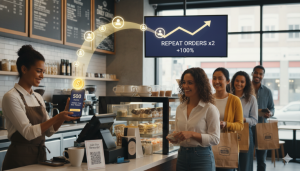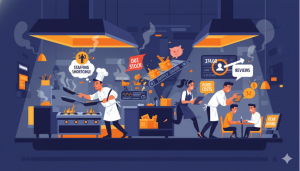It’s more like a hand-in-hand relationship when we talk about restaurant marketing objectives from any perspective.
In layman’s terms, let’s put the concepts about restaurant marketing objectives in an easily digestible manner.
Have you ever had the chance to hold one of those Russian Matryoshka Dolls? Even if you haven’t, you may have seen them on Google or somewhere at your friend’s place.

The Matryoshka doll is a set of wooden dolls that follow an unusual ‘Doll within Doll’ analogy.
The biggest of them encapsulates smaller dolls.
You keep on peeling the layers until the smallest one pops right out of the encasing. That’s how restaurant marketing objectives work. The base plan cycles around a restaurant business plan, which further branches into bigger modules.
Collectively speaking, the final form of the metaphorical Restaurant Matryoshka doll depends on smaller “objectives” that contribute to the overall shape of the project. Since we are looking at one gigantic social media presence for a business, we often fail to see the carefully crafted layers underneath – they all serve a purpose, and it is equally important to understand everything about them.
A comprehensive set of restaurant marketing objectives enable food business owners to manage marketing campaigns, run metrics on ROI portfolios, resource management, and competitor analysis. If done right, you are looking at a long-term win-win situation that pans out in favor of the restaurant for years to come.
Objectives of a Restaurant Business
When it comes to restaurants, what gets measured gets managed. To paraphrase Peter Drucker, the goal of marketing is to create and keep a customer. To do that, you first need to understand your objectives as a business. What are you trying to achieve? What are the objectives of a restaurant business for you? Are you looking to increase traffic during lunch hours? Do you want more customers dining in for dinner? What about generating repeat business or increasing average ticket size?
All of these are essential factors to consider when setting your marketing objectives. Objectives should be specific, measurable, attainable, relevant and time-bound (SMART). Once you have defined your goals, you can begin thinking about how best to achieve them.
You can pursue several restaurant marketing objectives, but it’s essential to focus on a few key areas that will have the most significant impact on your business. Here are a few examples, e.g. Increasing traffic during slow periods, increasing average ticket size, Generating repeat business, Attracting new customers, Generating repeat business, Improving customer satisfaction and alike.
No matter your objectives, make sure you have a plan to track and measure your progress. Only then will you be able to tell if your marketing efforts are successful.
What’s the Most Important Thing to Know about Restaurant Marketing Objectives?

First of all, each component of the restaurant marketing objective caters to a different breed of targets.
Let’s say you are looking to grow your social media presence for the restaurant business. The first thing to keep in mind is that such strategies are best served when run on different social media platforms. They are based on social media restaurant ads, expense management, and organic outreach STRICTLY on what? Yes, that’s right, the social media.
So, don’t go to an extent where you are mixing social media restaurant marketing objectives with search engine marketing campaigns. The latter is run to ensure a naturally occurring organic placement of keywords i.e. based on ads and SEO to gain visibility on Google, Yahoo, and Bing for that matter.
[INSERT_ELEMENTOR id=”2061″]
It’s Not a Magic Pill:
That being said, the MOST IMPORTANT thing to keep in mind is that any of the restaurant marketing objectives take time to bear results.
Keep your expectations short and realistic. Don’t think about overnight success, and don’t empty your pockets while executing the first batch of marketing strategies for your food business.
With that in mind, let’s take a look at a simple and easily executable plan for your name-brand food business. For the most part of the post, we will be focusing on helping startups to engage in getting started with restaurant marketing objectives with minimum chances of failure.
If you are already running marketing operations for your food business at full throttle, feel free to read our post on ‘Restaurant Social Media Marketing Strategies’ (Updated 2021 Guide).
Scaling Your Business with Sound Restaurant Marketing Objectives in 2021:

Right off the platter, we’ll get started with executing different elements of restaurant marketing objectives for a make-belief restaurant. Feel free to improvise the objectives and strategies as per your name-brand business requirements. In fact, improvisation is highly recommended because, at the end of the day, you know your competitors and marketing variants quite well as opposed to someone advising on the issue via the internet.
Your Restaurant’s Executive Summary:
This one’s the first and most basic element of an overall number of restaurant marketing objectives. Your executive summary outlines a couple of things that separate you from the competition.
For instance, if it’s a fast-food joint you are looking to open, state down why your joint is special and how it is different than the rest of the people who are operating the same business in the local vicinity.
The executive summary doesn’t have to have fancy-schmancy wording and elaborate paragraphs. 3 – 4 paras are more than enough because if that summary is going to be included in your restaurant business plan, then you need to captivate your partner’s attention right away.
Your Restaurant’s Unique Product and Services:
Case in point is the uniqueness factor here. Of course, all restaurants cater to their customers through food; that’s the common thing. Whereas, you have to focus on a blend of something special and an outside-the-box mentality.
Take the example of someone selling Acai Berry recipes at a local corner, or through an official Instagram page. Business owners in the smoothie’s industry, alleviate their unique selling proposition by highlighting how the nutritional value of their smoothies is better than traditional competitors.
More so, these business owners also promote healthy food choices by offering a mixture of different fruit combinations with a sense of freshness and tastefulness to attract customers.
In the food business, as part of restaurant marketing objectives, your unique product could be a homemade menu, an assortment of different beverages, and traditional family recipes that are not common elsewhere. Bear in mind that this was just an idea; the possibilities are endless as you begin to converse with mentors and experts who have been in association with F&B conglomerates before.
Competitor Research Within The Same Niche As Yours:
The next one on our list of restaurant marketing objectives is analyzing your competition and coming up with something better.
This is also one of the toughest and time-consuming elements of a marketing plan for restaurants because you don’t want to mess up on whatever your competitors are doing. So, bide your time and carefully comb through the following variables when you’re sniffing around for competition on the internet, or within the same block!
- Food Menu
- Whatever Your Competitor is Doing on Social Media via His/Her Official Restaurant Business Page
- Organic Keywords That They’re Ranking for On the Internet
- Food Distribution Channels (if/any) – Are They Using a Mobile Food App or Vice Versa?
- Overall Products and Services Offered
- Food of the Day, Discount Deals, Promo Code Campaigns Etc.
- Pricing Structure of your Competitors
Think about pushing your restaurant’s finest delicacies to the market under the ‘high-quality food at reasonable prices’ slogan. If you’ve got something better in mind, go for that. We just wanted to nudge you in the right direction to create the resonance effect.
Signing Up with a Food Delivery Services Partner:

As a startup, that’s where things tend to hit a snag if you were to sign up with a food delivery merchant. GrubHub, Food Panda, Uber Eats, and other companies charge a flat commission on each order that comes in from your customers through the merchant’s mobile app.
At the end of the day, if you have signed up for an account with such merchants that charge anywhere up to 35% commission on each order, you will not last long in the market. Mind it. There have been cases where people have started a food business with high expectations, only to partner up with shady merchants that have a knack for changing their fee structure policies without prior notice. These aspiring entrepreneurs had to throw in the towel long before the action began.
Sign Up for an Account on Blink for Restaurant Page To Get Started

Blink Co. is a culmination of bleeding-edge technology that helps food businesses, retailers, and F&B operators by prioritizing vendors’ business above everything.
In that sense, Blink Co.’s fee policies are based on a month-to-month subscription plan that fits right in where all kinds of startups and seasoned restaurant owners feel comfortable.
On top of that, since these restaurants don’t have to worry about paying premium percentages on each order, they can focus on maintaining their own marketing campaigns, monitoring customer analytics via Blink’s robust dashboard, fleet management, and many other KPIs that scale the business in tenfold.
Food Quality Vs Customer Churn:
Another point, when it comes to restaurant marketing objectives, is the overall quality of food and the way it’s packaged.
The general analogy is that high-quality food works to retain the majority of customers, but it comes with a cost. You see, better packaged and professionally cooked food is sold at a slightly higher price as opposed to traditional menus that don’t take long to prepare.
In the latter case, the Chefs are pressed for time; the overall hygienic standards of the kitchen might be low, and they are more than likely to use inferior quality ingredients that are harmful to consumers’ health.
The best course of action is to create multiple price points for different qualities of food that will be part of your final menu.

Take the example of the highlighted figures in the image above. Your low-quality beverage which is also the cheapest could be a high ticket item for an average of $5 per unit price. Likewise, the cost in numbers escalates when the food quality goes up.
The key is to maintain a healthy relationship between high-quality & low-quality ingredient menus to cater to consumer requirements. Some people prefer fast food that’s cheaper because they are in the middle of everyday hustles. Others, bide time to order the luxury food menu online because they want to relish each and every single morsel on their plate.
In that context, run A/B tests by splitting up your menu and running it at a different time of the day. Gather feedback based on online food order reviews and see what works best for your restaurant.
Answer the 5 Common ‘W’s’ of Restaurant Marketing Objectives:
Last but not the least, here are some additional common questions that you need to answer during the course of your restaurant marketing objectives’ execution:
- What are my average customer’s connection points to my food menu?
- What is the best, or the most popular method that my restaurant business competitor is using to market his products and services?
- What factors in my restaurant food business create high interest from customers’ point of view?
- What’s the one dish or specialty item on my menu that keeps customers coming back for more?
- Who is my target audience and the average buying capacity of a normal customer out there?
At the End of the Day:
Just as we said earlier, do not expect overnight success from any type of restaurant marketing objective. It will take time.
Regardless of which direction you are planning to head your marketing strategies, don’t forget that the entire process is based on a marketing budget. To avoid overspending, run lots of segmented tests and fiddle around with different dollar values for your marketing campaigns and restaurant scalability objectives.
Meanwhile, establish vendor relationships to escalate the development process. Be polite to your competitors, and if they are willing to offer help, go ahead. It’s a long-haul process where you need to be calm and patient to let your restaurant brand identity mature in terms of age. People naturally remember old and popular food vendors as compared to the new ones that pop up on the radar every now and then.
So, keep at it and progress at a steady pace to avoid feeling overwhelmed.
Good luck.
[INSERT_ELEMENTOR id=”2061″]
Related Articles:
 Blink’s Special: Chefs Talking about Restaurant Industry in 2021 & Beyond
Blink’s Special: Chefs Talking about Restaurant Industry in 2021 & Beyond
 How to Attract More Customers to Your Restaurant (*Updated 2023 Guide)
How to Attract More Customers to Your Restaurant (*Updated 2023 Guide)
 Food Delivery Service Benefits for Restaurants In 2021
Food Delivery Service Benefits for Restaurants In 2021
 8 Smart Ways To Grow Your Online Food Delivery Orders In Saudi Arabia
8 Smart Ways To Grow Your Online Food Delivery Orders In Saudi Arabia
 13 Restaurant Instagram Marketing Strategies
13 Restaurant Instagram Marketing Strategies




